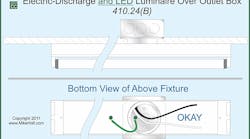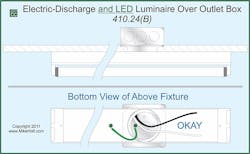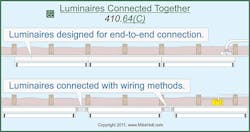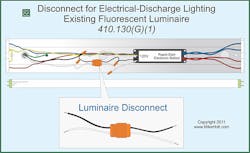NEC Rules for Installing Lighting on Circuits Greater than 30V
First, let’s make the distinction between Articles 410 and 411 of the 2011 NEC. Article 410 provides the requirements for installing luminaires, lampholders, lamps, and decorative lighting products on circuits greater than 30V. Article 411 addresses lighting systems operating at 30V or less.
Don’t let this Article’s length and degree of detail throw you. It’s nicely broken up into 16 parts (see SIDEBAR: Breaking Down Article 410), most of which won’t apply to a given application.
LEDs in closets
Only the following types of luminaires are permitted to be installed in a clothes closet [410.16(A)]:
- Surface or recessed incandescent or LED luminaires with an enclosed light source.
- Surface or recessed fluorescent luminaires.
- Surface-mounted or recessed LED luminaires identified for use within the closet storage space.
Incandescent luminaires with open or partially open lamps and pendant-type luminaires must not be installed in a clothes closet [410.16(B)].
Luminaires must maintain a minimum clearance from the closet storage space as follows [410.16(C)]:
- 12 in. for surface-mounted incandescent or LED luminaires with an enclosed light source.
- 6 in. for surface-mounted fluorescent luminaires.
- 6 in. for recessed incandescent or LED luminaires with an enclosed light source.
- 6 in. for recessed fluorescent luminaires.
Surface-mounted fluorescent or LED luminaires are permitted within the closet storage space if identified for this use.
The 2008 NEC added allowances for LED luminaires in clothes closets [410.16]. However, its wording inadvertently required special identification for the application of an LED luminaire in a closet. The intention was to require special identification to install it in the storage space. New wording in the 2011 NEC clears up this confusion.
Connection of electric-discharge and LED luminaires
The 2011 Code changed the requirements for boxes and wiring methods for electric-discharge luminaires to include LED luminaires.
- Electric-discharge and LED luminaires supported independently of the outlet box must be connected to the branch circuit with a raceway or with Types MC, AC, or NM cable [410.24(A)].
- When an electric-discharge luminaire or LED luminaire is surface-mounted over a concealed outlet box and not supported by the outlet box, the luminaire must be provided with suitable openings that permit access to the branch circuit wiring within the outlet box [410.24(B)] (Fig. 1).
- Electric-discharge luminaires can be cord-connected if the cord is visible for its entire length and is plugged into a receptacle — and the installation complies with 410.62(C).
Bonding
In previous editions of the NEC, the rules addressing the bonding of luminaires have been a hodgepodge of requirements in an illogical arrangement. Revisions in the 2011 NEC resulted in a more user-friendly Code, but no technical changes were made.
Luminaires must be connected to an equipment grounding conductor of a type recognized in 250.118. If of the wire type, the circuit equipment grounding conductor must be sized in accordance with 250.122, based on the rating of the overcurrent device [410.44].
Exception No. 1:If an equipment grounding conductor isn’t present in the outlet box for a luminaire, the luminaire must be made of insulating material and must not have any exposed conductive parts.
Exception No. 2:Replacement luminaires can be installed in an outlet box that doesn’t contain an equipment grounding conductor if the luminaire is connected to one of the following:
- Grounding electrode system [250.50].
- Grounding electrode conductor.
- Panelboard equipment grounding terminal.
- Service neutral conductor within the service equipment enclosure.
Exception No. 3:GFCI-protected replacement luminaires aren’t required to be connected to an equipment grounding conductor of a type recognized in 250.118 if no equipment grounding conductor exists at the outlet box.
This is similar to the rule for receptacle replacements in locations where an equipment grounding conductor isn’t present in the outlet box [406.4(D)(3)].
Wiring
Because LED drivers and electric-discharge luminaires are similar, the logical place to include LED requirements is alongside electric-discharge luminaires. Where LED luminaires are supplied via a cord-and-plug connection, they must now comply with the provisions of 410.62(C).
A luminaire can be cord-connected if:
- The luminaire is mounted directly below the outlet box, and
- The flexible cord:
- Is visible for its entire length,
- Isn’t subject to strain or physical damage [400.10], and
- Terminates in an attachment plug, canopy with strain relief, or manufactured wiring system connector complying with 604.6(C).
Luminaires as raceways
In previous editions of the NEC, to see if you could use a luminaire as a raceway, you’d find your answer in 410.64. The answer was a resounding “no,” it isn’t permitted. Section 410.65, however, provided an exception to this rule. This was confusing. The exception to the rule logically goes in the section that provides the rule. Deleting 410.65 from the 2011 NEC and incorporating this text into 410.64 ended this particular confusion. Now 410.64 clearly states the conditions under which conductors can be pulled through luminaires:
- When the luminaire is listed and marked for use as a raceway [410.64(A)].
- Luminaires identified for through-wiring as permitted by 410.21 [410.64(B)].
- Luminaires connected together can include wiring to feed the interconnected luminaires, within limits [410.64(C)] (Fig. 2).
Installing lampholders
Previous editions of the Code specified that lampholders in damp or wet locations must be of the weatherproof variety. While this makes sense for wet locations, it doesn’t seem to make sense for a damp location. The 2011 NEC now requires that these lampholders be listed for the environment in which they’re installed [410.96].
Section 410.11 has long required that luminaires installed near combustible material contain shades or guards to prevent the ignition of surrounding products. While that requirement certainly makes sense, there’s a gaping hole in the rule — it doesn’t address lampholders.
Lampholders often contain lamps that produce more heat than a standard luminaire, yet very seldom has an apparatus been designed to contain that heat. Because lampholders aren’t included in the definition of luminaires, the 2011 Code added section 410.97. The location of this new section in Part VIII is logical.
“410.97 Lampholders Near Combustible Material. Lampholders must be constructed, installed, or equipped with shades or guards so that combustible material isn’t subjected to temperatures in excess of 90°C (194°F).”
Recessed luminaires
Part X of Art. 410 applies to luminaires installed in the recessed cavities of walls and ceilings. That would suggest that it applies to luminaires in suspended ceilings. But does it, actually? Previous editions of the NEC didn’t say, thus leaving installers in suspense on this issue. The 2011 NEC clarifies that these rules apply to suspended ceilings [410.110].
With the increasing popularity of LED luminaires, the Code needed to address requirements for their installation. Where these are of the recessed type, they must be marked as “Type IC,” or must have a clearance of 3 in. from thermal insulation [410.116(B)].
Electric-discharge lighting (1,000V or less)
The NEC defines electric-discharge lighting as systems of illumination that use fluorescent lamps, HID lamps, or neon tubing [600.2]. Even though this term is used in more than one Code Article, it is defined in 600.2. The general rule is that when a defined term is used in two or more articles, the definition of that term should be included in Art. 100.
Indoors, fluorescent luminaires that use double-ended lamps (typical fluorescent lamps) and contain ballasts and that can be serviced in place must have a disconnecting means [410.130(G)]. If an existing luminaire doesn’t have such a disconnect, the 2011 NEC now requires you to add it when you replace the ballast for that luminaire (Fig. 3). Considering the low cost of these disconnects and the increased safety, few people seem to be against this.
The requirement for the ballast disconnect doesn’t apply to:
- Dwellings and associated accessory structures [410.130(G)(1)].
- The emergency illumination required in 700.16 [410.130(G)(1), Exception No. 2].
- Cord- and plug-connected luminaires, if you install an accessible separable connector (or an accessible plug and receptacle) as the disconnecting means [410.130(G)(1), Exception No. 3].
- Industrial establishments with restricted public access where written procedures and conditions of maintenance and supervision ensure that only qualified persons will service the installation [410.130(G)(1), Exception No. 4].
If you install more than one luminaire and it’s supplied by a branch circuit that isn’t of the multiwire type, do you have to install a disconnecting means for every luminaire? Not if you provide a means of disconnecting such that the illuminated area will not be left in total darkness [410.130(G)(1) Ex 5].
Multiwire branch circuits
When fluorescent luminaires are on multiwire branch circuits, the disconnect must simultaneously break all circuit conductors of the ballast. This includes disconnecting the neutral conductor, otherwise, a false sense of security can result in an unexpected shock.
The disconnecting means must be accessible to qualified persons. If it’s external to the luminaire, it must be a single device located in sight from the luminaire.
Efficiency
You hear a lot about energy-efficient lighting, but what about efficiency when designing and installing a Code-compliant lighting system? The key to this efficiency is to greatly reduce the amount of reading you must do without missing applicable requirements.
First, work with a reputable electrical distributor to ensure the components are genuine and manufactured to the requirements of Parts 7, 9, and 11 of Art. 410.
The first four Parts of Art. 410 occupy only about three pages, but reading all of that for each lighting design still takes time. If you’ve read them recently, just scan the subsection headings (such as, “Bathtub and Shower Areas”) for those that apply to your specific installation.
Don’t scan through Part V or Part VI. Instead, read them with an understanding of what they are trying to accomplish:
- The main goal of Part V is that you bond non-current-carrying metallic objects just as you do for any other installation.
- The main goal of Part VI is to ensure that the wiring on or within luminaires is properly protected and supported.
Then, check the remaining Parts to see which may be relevant to your specific installation.
Holt is the owner of Mike Holt Enterprises, Inc., Leesburg, Fla. He can be reached at www.mikeholt.com.
SIDEBAR: Breaking Down Article 410
The first five parts of Art. 410 are in a logical sequence. The requirements they provide are mostly mechanical in nature. This sequence is followed by the luminaire wiring requirements in Part VI.
The seventh, ninth, and tenth parts provide requirements for manufacturers. Specify and install only equipment that conforms to these requirements. Part VIII provides requirements for installing lampholders. The rest of Art. 410 addresses specific types of lighting.







